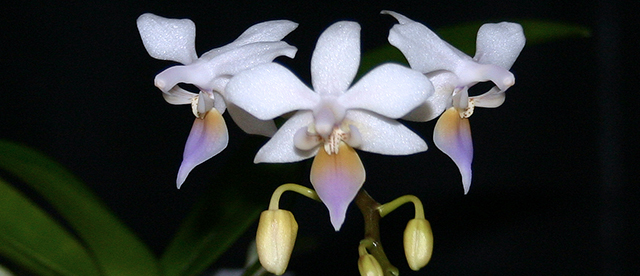
Happy New Year and thank you to our current patrons and friends that have supported us over the years. Welcome to our new friends that have starting to discover the exciting new breeding direction of coerulea Phalaenopsis. 2007 was a fun year for us as we've started to see some our work come to fruition with some first blooms that have validated our program. The greenhouse is full of new crosses that are spiking for the first time and the lab is full of even more exciting crosses that represent the leading edge in coerulea Phal breeding. 2007 was a great year and looking forward we can see that 2008 is going to be even greater.
Some of our first breeding experiments with equestris var cyanochilus are blooming out for the first time now and even more are spiking. So far we've had one significant success and we're closely watching the other crosses to see what they are going to reveal about how well the cyanochilus variety will carry the coerulea color into its progeny.
The First Tetraploid Phal equestris var cyanochilus:
Creating tetraploid lines of coerulea phal species has been a core part of strategy for improving the color of coerulea phal hybrids. The very first cross we were able to treat with colchicine was an equestris var cyanochilus cross between 'Martel's Blue' and 'ABC'.
These seedlings came out of the lab early in 2007 and proved to be stronger growers than their untreated 2n siblings. This was contrary to the myth that colchicine treated seedlings are poor growers. Later in 2007 we did guard cell measurement survey of the 2n and potential 4n seedlings. Many of the potential 4n seedlings appeared to be tetraploid during that initial survey based on guard cell measurements and comparisons with the known 2n seedlings.
In late Dec 2007 the first of the potential tetraploid seedlings bloomed out and we are very happy to announce that flower size almost certainly confirms the plant is a tetraploid. Later in 2008 we will be doing root tip gene counts on this plant to certify that it is a tetraploid.
This is a significant advance and we will begin line breeding the 4n plants now and it should be much easier to increase the pigment density in a the tetraploid line. The intensity of the lip is already somewhat more intense than either 2n parent.
Left: equestris var cyanochilus 'Martel's Blue' 2n
Right: equestris var cyanochilus ('Martel's Blue x 'ABC') 4n
On the left is the diploid pod parent and on the right is its probable tetraploid progeny. The overall size and shape of the flower segments had improved considerably. The intensity of the pigments in the lip has increased some. In the greenhouse the difference is more obvious.
The Norton Indigo Violaceas:
As of this year, we now have 4 confirmed indigo Norton violaceas to work with. 'Sapphire's Navy' bloomed for the second time this year and both the color and intensity of the pigments improved. This plant has been used in 3 crosses now and is going to be one of the foundations of our coerulea breeding program. We've been successful in remaking Dtps. Kenneth Schubert with violacea 'Sapphire's Navy' and a good coerulea pulcherrima. This will be potentially give rise to a new generation of Kenneth Schuberts with even more intense color.
We've also been able to self violacea 'Sapphire's Navy' this year and the resulting seedlings will be colchicine treated to create one of the first generations of tetraploid indigo violaceas. This the most significant accomplishment this year and will allow us to start breeding with large tetraploid whites once these seedlings bloom out.
We currently have Phal. Equalacea and Dtps. Purple Martin in flask using violacea 'Sapphire's Navy'. These seedlings have been growing very quickly and we should be able to make some available to the public later in spring 2008. These crosses have a huge amount of potential.
New Breeding Lines:
For over 5 years we've been planning out some new coerulea Phalaenopsis breeding lines. Many experiment crosses have been made and this year the first of some of our unique are starting to spike. In the months to come we will start announcing some new crosses and sharing the results of this research. This is an exciting time for us and we are now anxiously awaiting to see if our breeding theories are going prove out to be correct.
The future of coerulea Phalaenopsis is bright and we are looking for to an exciting and rewarding 2008. We hope you have a great and are looking forward to seeing what you bloom out from our crosses.
Happy growing!
